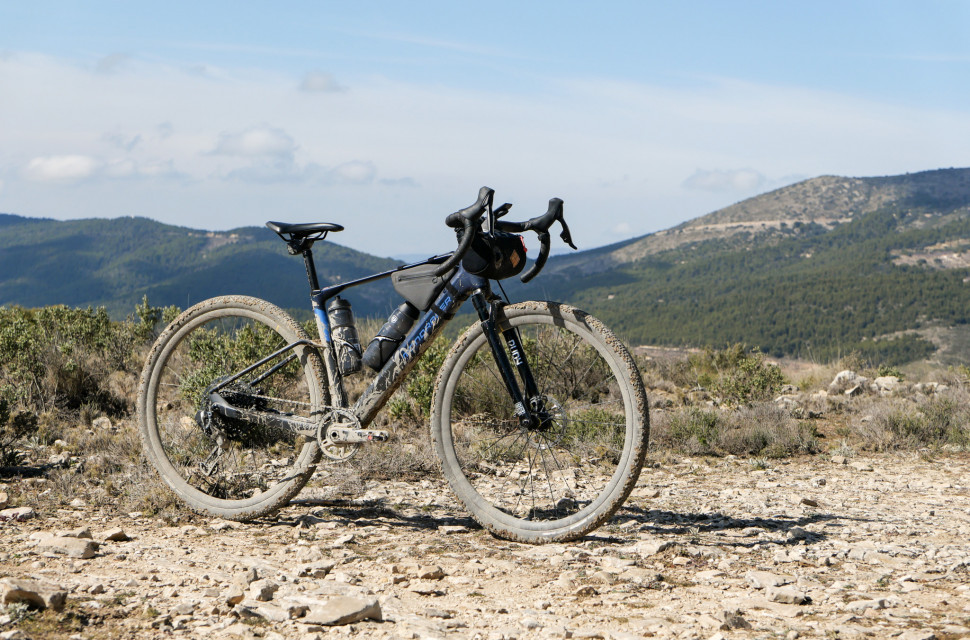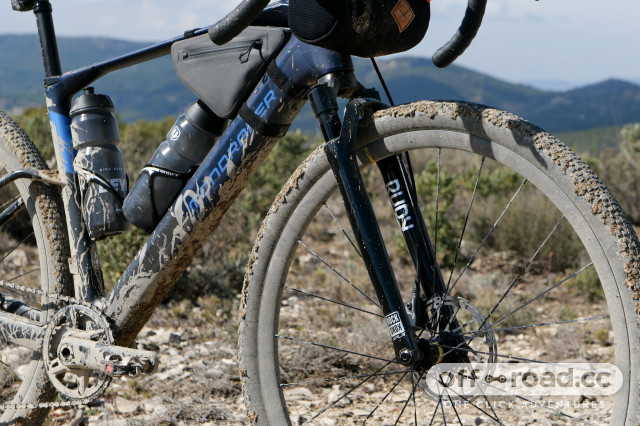Mondraker Dusty XR - First ride review

The Spanish mountain bike brand, Mondraker, has deviated from its usual programming with the release of the Dusty. It's an e-gravel bike that utilises the brand's boundary-pushing Forward Geometry concept with some interesting innovation. We were invited to some picturesque Spanish mountains near Alicante to take the range-topping Dusty XR out for a first spin.
Mondraker's history is rife with milestones, ushering in the Forward Geometry concept, the Zero suspension kinematic, and having a rider on each step of the podium at the Downhill World Championship in Val di Sole in 2016. The Dusty marks yet another as it's the first time the brand has turned its attention away from mountain biking - well, kind of...
The Dusty is an e-gravel bike, which is an interesting move as a first step into the world of gravel from a previously mountain bike-only brand, but Mondraker has chosen this route as it recognises the exponential growth that the e-bike market is experiencing. It's not just about the sector's growth, however, as the brand reckons that it adds a whole chunk of versatility to the bike.
We'll lay off the details of the techy goodness thrown at the Dusty for now as we have a full story covering it all. First, let's go over the specification that the Dusty XR, our test bike for the day, gets.
So the Dusty XR, as with each of the bikes in the Dusty range, is built around a carbon frame that benefits from internal cable routing but that's not to say that the Dusty XR needs it. That's because both its shifting and dropper post is wireless. The mullet drivetrain is supplied by SRAM and combined with the brand's Force eTap shifters, flat-mount brakes and cranks with the XO1 derailleur and an Eagle 12-speed cassette from SRAM's mountain bike line-up.
Then, providing compliance to the front end is a RockShox Rudy Ultimate with 40mm of travel. This fork comes with the Race Day damper - found also on the brand's SID cross-country fork - but tunes it specifically for the needs of gravel riding. It then uses the SoloAir air spring.
Moving on, there's a RockShox Reverb XPLR dropper post with 75mm of drop and that's home to a Fizik Terra Argo X7 saddle. The bike rolls on a pair of Mavic Allroad Pro Carbon SL Disc wheels that are wrapped with 45mm wide Maxxis Ramblers featuring dual compounds and EXO casings.
Oh, and the motor is the Mahle X20, and this is the first time we've seen it kitted to a gravel bike. However, it's not just been taken from a road bike and bolted onto the Dusty, as it's been tweaked and tuned to better suit gravel riding. It's said to offer a seriously natural power delivery that mirrors the effort you put in. So if you're chilling on some flat ground, it'll add a smidge to give you a bit of a hand but if you were really putting the power down, the motor will ramp up its assistance. We're told that this system will offer up to 180km of range with its 350Wh battery, without the use of the 171Wh range extender.
Moving onto the bike's geometry which, as you might expect from Mondraker, is pretty forward-thinking. The medium Dusty that I rode has a 70-degree head tube angle, a 74-degree seat tube angle, and a 425mm chainstay, and gets a mighty long 405mm reach.
The Dusty in this configuration is claimed to weigh in at 13.8kg and for an e-gravel bike, that's not too shabby at all. And this particular build will set you back £8,800 but prices start at a friendlier £4,500.
Mondraker Dusty XR - Ride impressions
After a good 50km aboard the top-end Dusty XR, I can confirm that it's a mountain biker's gravel bike in every way shape and form. That’s if the suspension fork and dropper post didn't already give that away.
The 50km ride took us through every kind of gravel, including long, sweeping descents coated with fine gravel and fast chunky fire roads with some loamy and rocky single-track thrown in for good measure. To push the e-gravel bike’s uphill capabilities, there were some punishingly brutal climbs thrown in with a fair share of tech, too. After the 50km, I've concluded that the Dusty is a bit of a belter but one that shines its brightest when being pushed through the techiest of descents.
That said, the Dusty isn't solely about silly tech. Its saddled position isn't too far from the norm for a size medium gravel bike and the weight distribution is well balanced because its longer reach takes up some stem length real estate. When firing the bike uphill, it remains nicely in check, and I never felt the need to consciously weigh the front end during steeper sections which is impressive considering how outwardly long and slack its figures are.
Aiding climbing further is the mullet drive train set-up. Rather than using a full Force groupset, the dusty XR rocks Force brakes, levers, and cranks but borrows the XO1 mech and an Eagle cassette from SRAM’s MTB line-up. This boosts the range far beyond what's found on most gravel and road groupsets, making uphill efforts that bit easier, thanks to the dinner-plate-like 52T low gear. What gravel purists will find though, is that the jumps between the easier three to four gears are larger than non-MTB counterparts, and for the gravel application they’re very noticeable.
As a mountain biker, the bike's 13kg weight isn't an issue, even when cornering, because I spend most of my time riding shifting things far heavier about. Thanks to its stretched wheelbase, the Dusty is stable and holds its line with a tenacity that shorter bikes simply can't replicate. Even when the tyres break traction over loose gravel, the slide is predictable and more than manageable - and ridiculous fun. Sliding the bike felt very much like sliding the Merida One-Forty. Because it’s so long, weight remains central and easy to distribute. When traction is nil, it encourages a confidence-inspiring sense of stability.
Touching back on the weight, the Dusty, isn't actually that heavy for an e-gravel bike. Mondraker’s experience in making mega lightweight cross-country frames is clear as the frame only is claimed to weigh just 1,200g.
Moving on and the Mahle X20 motor has proven to be a total stunner. It's refined in both its ergonomics and power delivery. When scrolling through the power modes, the drop-based buttons give a little vibration to remind you of what you're doing and the top tube unit displays what mode you’re in, and how much battery you have left.
This is topped off with the removable and wireless head unit. It rustles up all the ride information you'll need, including range, distance and the like. Though, because the top tube unit comprehensively displays the battery level and power mode, you don't need to rely on the head unit, which is handy if you're after a more traditional cockpit. Though one niggle, the head unit doesn't turn on with the bike, so you’ll have to switch it on separately. It does connect automatically, however.
But the finesse with which it delivers its power is the real gem here. Mahle says that the motor mirrors your power, similar to the e-MTB mode on Bosch motors or Trail on Shimano units and this is only to be appreciated. If you're chilling out, putting little effort in, so will the motor but if you smash on the pedals, it'll up the output in each mode. This makes the motor feel incredibly natural, resulting in an e-gravel bike that feels like a regular gravel bike, but with a helping hand. Unlike e-MTBs, it gives you a helpful tow, rather than feeling as if you're pulling back on the throttle.
Though, throughout the ride, there were long periods of time where I rode without the assistance of the motor; generally through descents, flat sections, and mellow, non-technical climbs. This proved that drag is nonexistent in this unit. Riding without constant help from the X20 resulted in an impressive range, having completed the 50km, and 4,000ft of climbing with around 47% of power left, all while flicking through each of the modes as and when the time called for it.
When designing the frame, the brand's engineers carefully built in a bunch of compliance around the rear end, both by dropping the seat stay junction and by tweaking the carbon layup in this area. This has been done with the aim of helping the bike to remain poised in rough sections and that, I'm pleased to report, it is.
The present level of rear-end flex adds a huge benefit in two applications. Firstly, the bike remains reasonably comfortable when in the saddle for extended periods but secondly, it enhances rear-end traction, while taking the sting out of bigger hits. And here I am, already talking about the Dusty as if it's a mountain bike...
Mondrakers 'aggressive gravel' approach when designing the Dusty is stark. That's purely because the bike excels when flung down techy sections that I'd never have thought a gravel bike would be at home. When tipped into steeper singletrack littered with immovable rocks and chunks, the Dusty took it well within its stride, utilising its long reach and slack head angle perfectly by supporting the front end, and upping the confidence. The suspension fork plays a huge role here, too, as it allows the rider to seriously hang onto the front brake without the fear of the front wheel breaking traction, all while making for a smoother and more manageable front end.
The 425mm chainstay then brings the rear tyre tight into the rear of the bike which adds a welcome hint of flickability, which proves valuable when negotiating hairpin corners, or twisty sections of trail.
While it’s through techy singletrack where I had the most fun, the Dusty doesn't pigeonhole itself as only a mega-aggressive gravel bike, because the bike’s length and compliance mean that it’s no slouch when dialling the stoke back and blasting over fire road. Its overall stability results in loads of comfort at speed, and thanks to its raft of mounting points, the Dusty is more than ready for a bikepacking epic, which can be extended thanks to Mahle’s range extender which adds another 171Wh.
But even then, if the more aggressive shenanigans that the Dusty XR can get you into aren’t really for you, Mondraker offers the bike with a rigid, gravel-orientated carbon fork on its lower models. Opting for one of these makes for a more efficient and lighter bike and grants the user more mounting points for water or luggage.
When designing the Dusty, Mondraker set out to create the mountain biker's gravel bike that doesn't hold back on versatility and the brand deserves all of the praise as it’s hit the nail on the head. The benefit of the Forward Geometry concept and implementation of useful compliance results in a sure-footed e-bike that will appeal to those who want to push the envelope of their gravel riding, whether in distance or when descending. Primarily, it's a capable, technical riding powerhouse that'll tease the inner hooligan of even the timidest of riders but when dialled back, it’s an easy-to-tame beast that’ll happily lay back, relax, and munch miles.





















